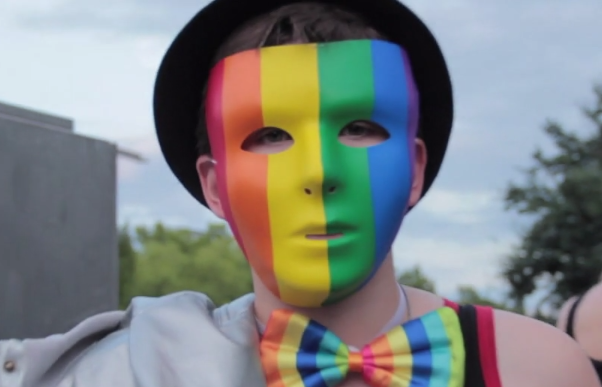Story by Kris Seavers and Mikaela Casas
Video by Mikaela Casas and Caroline Touma
“Day” by Travis Jolly (Ect0)
As the minutes ticked closer to 8 p.m. on Saturday, Sept. 20, hundreds of motorcycles, pick-up trucks, Fiats and one MetroRapid bus lined up on San Jacinto Boulevard. In one block, a police Hummer sat idle only feet away from a life-sized Fleshlight dancing atop a parade float. Lady Gaga’s “Born This Way” blared from a pair of speakers as a group of young women sprayed hair products into each other’s pink and purple wigs.
At the corner of 12th Street and San Jacinto Boulevard, a countless number of people, from Millenials to babies in strollers, sported white t-shirts with the rainbow outline of an apple printed on the front.
Nine thousand participants came out to the 2014 Austin LGBT Pride parade, twice the number of registered participants in last year’s parade. Almost half of those participants – as many as 3,500 – were Apple Inc. contingents. This is the first time the company has participated in a pride parade outside of San Francisco.
Earlier in the day, Diego Sans and Pablo Hernandez sat on the curb outside of the fences at Fiesta Gardens, taking a break from modeling at the Andrew Christian – a men’s underwear a sportswear designer – tent. Inside the fence, the annual Austin Pride festival, which precedes the parade, included drag queen performances and local vendors. Wearing matching neon army shorts and tank tops, Sans and Hernandez sat and discussed the festival and how different it was from other cities they had visited.
“Austin is not a big LGBTQ [lesbian, gay, bisexual, transgender and queer] city when you compare it to Los Angeles and New York,” Sans, who volunteered for an LGBT community center in Sao Paulo, Brazil, says. But he believes the weird city’s pride events are still important. “Pride helps with bullying. It’s important for us to try to educate because people don’t think about the impact that their negativity has,” Sans says.
Texas State University sophomore Angela Jenkins, who attended the festival and the parade with her girlfriend says she also thinks Austin’s LGBT pride events provide an important space for the community. “I feel really comfortable and accepted at pride,” Jenkins says. “[In Austin] there’s already such a supportive culture there that people like to come out and celebrate being gay.”
This was Jenkins’ third Austin Pride, and she says she has noticed more and more corporate sponsors every year. “The Apple representation is pretty interesting,” she says. “I think it’s amazing because it shows how acceptance of the gay community is becoming more mainstream.”
Christina Rose, an Apple employee who participated in the evening parade, says she was happy to see Apple “coming out” for the event and supporting members of the lesbian, bisexual, gay and transgender community. “As an employee, I just think it’s genuinely amazing that there’s that many of us out here to support the community inside of Apple and just the community as a whole, so I’m really excited,” she says.
Jorgen Lindberg sat with his wife and 4-year-old daughter, Amelie, who stared wide-eyed at the idle floats as they waited for the signal to start. Lindberg, who is from Stockholm, Sweden, says the parade expresses the diversity of Austin. “I think it’s a good thing to have difference,” he says.
At 8:04 p.m., the parade began, turning the corner onto Congress Avenue against a peaceful backdrop of the capitol building. Thousands of Austinites lined the sidewalk, calmly anticipating the parade. Drag queens, drill teams and organizations like Parents and Friends of Lesbians and Gays marched and danced as they passed the crowd.
Soon the Apple employees, too, were making their way down the parade route. Someone who didn’t know better might think the tech company was the main event. The procession of white t-shirts stretched for more than three blocks, with many employees handing out gift cards for one free iTunes song.
Apple CEO Tim Cook chimed in on Twitter. “A shout-out to 3000 Apple employees and their families marching in the #AustinPride parade! Inclusion inspires innovation. #applepride,” the Tweet reads.
In the ongoing national conversation about gay rights, Apple has made its stance clear and put a spotlight on Central Texas. Jenkins says that for her this is good news for Austin’s gay community and the gay community at large. “It reflects back to how our country as a whole is changing and becoming more accepting and aware of gay rights,” she says.












































